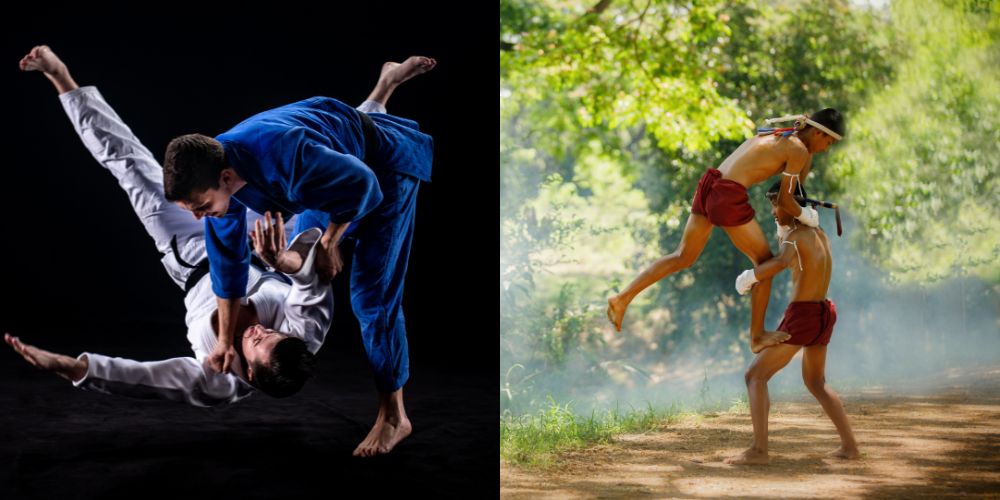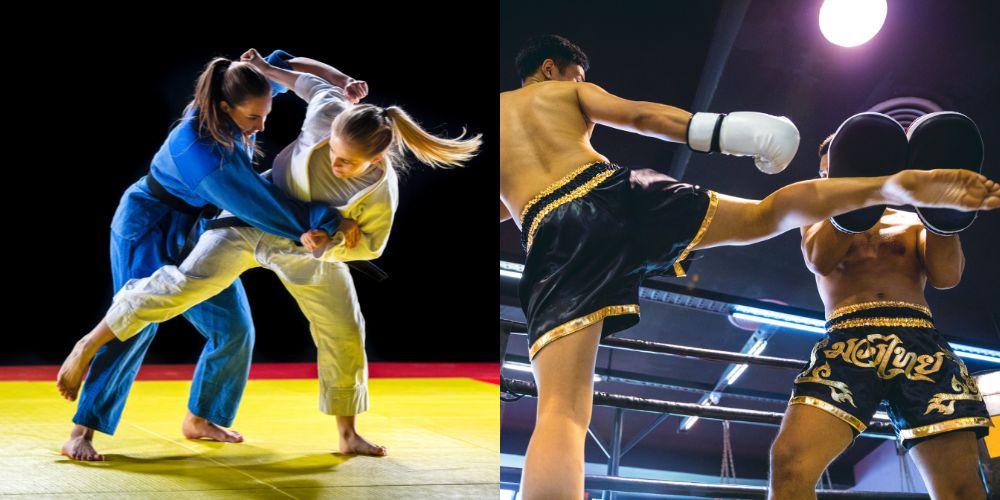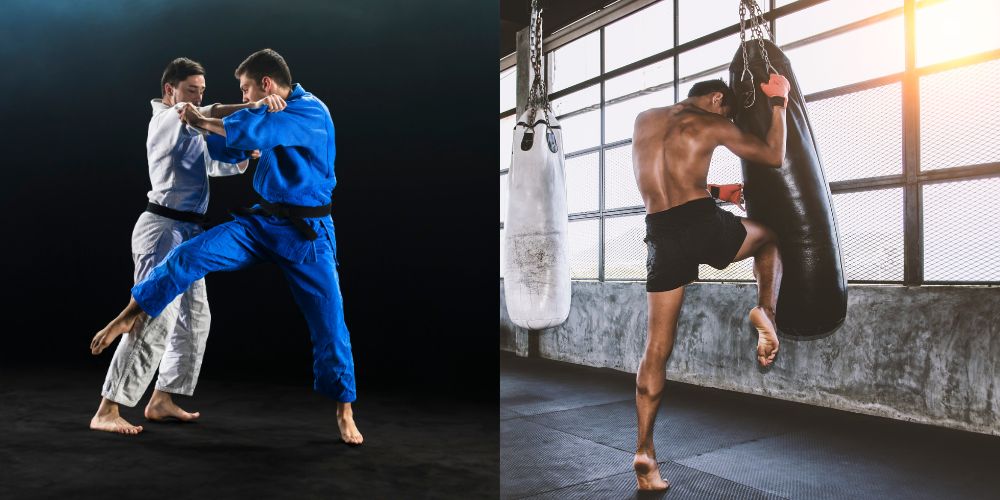Although MMA has demonstrated how things play out in practice, style vs. style comparisons never get old. But all styles still battle for practitioners, and each has something unique. Today we will compare Muay Thai and Judo and see what they bring to the table.
Muay Thai is a brutal and highly effective striking martial art and a well-developed combat sport. It uses strikes with all limbs and stand-up grappling in the form of clinching. Judo is a Japanese grappling martial art and an Olympic sport where the goal is to throw the opponent to the ground, pin him or make him submit through a choke or joint lock.
Judo and Muay Thai are extremely popular worldwide as separate sports, as self-defense systems, and as crucial parts of MMA, so to compare them properly, we must go through every aspect in detail.
What Is Muay Thai
Muay Thai is a striking combat sport and martial art, and it is Thailand’s national sport and pride. It is commonly called the “Art of 8 Limbs” because it allows punches, kicks, elbows, and knees.
Muay Thai, translated as Thai boxing, can be traced back to the battlefields of Siam in the 13th century, where soldiers used it for warfare.
It eventually became a pastime and a sport until it reached its current form in the early 20th century when It came in contact with Western boxing and adopted the ring, boxing gloves, timed rounds, and many other elements we recognize today.
Because of the use of all limbs, in addition to extensive clinching and close-range fighting, Muay Thai is proven to be one of the most ferocious and functional martial arts on the planet, and it is extensively used in MMA for this reason.
What Is Judo
Judo is a grappling-based Japanese martial art and an Olympic sport. The goal of Judo is to control and dominate an opponent on the ground by using various throws, pins, and submission holds.

How to Dominate Every Fight with Raw, Explosive Power No One Can Match
Discover the underground blueprint that has quietly turned MMA hopefuls into legends, using nothing but sheer, brute force and bulletproof conditioning techniques.
Judo was created by Jigoro Kano, who learned traditional Japanese jiu-jitsu in the late 19th century. He gradually enhanced the old techniques he learned in numerous ways, emphasizing freestyle practice and sparring above strict forms.
He worked relentlessly to spread his martial art worldwide, inspiring the creation of many other styles like Sambo and BJJ. In 1964 Judo was included in the Olympic Games and continued growing in popularity. Today, Judo is one of the most popular and practiced grappling styles.
Kano’s innovations in Judo, such as the use of colored belts to indicate rank, the usage of a gi, and the differentiation between different training methods, have been borrowed by countless other martial arts.
Key Differences Between Muay Thai and Judo

Rules and Objectives
Muay Thai
- Muay Thai is a striking sport, with grappling only limited to clinch work.
- Punches, kicks, knees, and elbows are allowed.
- Fights are held in boxing rings, and fighters wear boxing gloves as the only protection.
- Matches are separated into 3-minute rounds with 1-minute rest in between them.
- A match can be won by a knockout, technical knockout, or a judge’s decision.
- Judges score the fights based on different criteria like damage dealt, number of strikes landed, and aggression, among others.
Judo
- Judo is a grappling only sport with no striking allowed.
- The main goal in competition is to perform a clean throw which leads to a direct victory called an ippon.
- Minor throws and not perfect techniques are scored as waza-ri and the accumulation of two waza-ri sums to an ippon.
- Points are also earned for pins on the ground, and if no ippon is reached, the winner is decided on points.
- Matches are contested on an open mat, and the competitors wear judo gis.
- Matches have 5 minutes in length.
- Elbow locks and chokes are legal and lead to a direct victory if finished.
Techniques
Muay Thai
Muay Thai features punches, kicks, elbows, and knees. Punches are similar to those in Western boxing, but the overall level is much lower, especially in Thailand, where punches are scored less than kicks.
Kicking is where Muay Thai shines because of the specific style of throwing. The aim of the Thai style kicks is to be delivered with full power with maximum torque from the hips and land with the shin to deal the most damage.
Elbow strikes are also unique to Muay Thai and are used from the clinch and mid-range. Clinching is also a vital element of Muay Thai, and unlike other striking sports, it is allowed and scored highly, making it a viable tactic to win a fight and not only to stall the action.
Judo
Judo methods are divided into three categories: nage-waza (throwing techniques), katana-waza (grappling techniques), and atemi-waza (striking techniques). Striking is only present in kata and is prohibited in sparring or competition.
Judo’s power comes from its throwing skills. They are performed by breaking the opponent’s balance and throwing or sweeping him. The nage waza techniques are further subdivided into standing and sacrificial techniques, each of which has a few more categories depending on the finer details of execution.
For most of Judo’s history, any portion of the body could be used for throws. Still, since 2010 the legs are not allowed to be touched when standing, effectively prohibiting double- and single-leg takedowns to differentiate the martial art from wrestling.
Judo also features a wide range of submissions, but only joint locks that attack the elbow and wrist are allowed alongside a few different chokes in competition.
Takedowns
You might think there is no point of contact in the takedown department, but Muay Thai allows trips and throws, so some techniques are similar to what judo guys do.
For example, the inner trip or ko uchi gari is also used in Muay Thai, but it is done easier off of a caught kick. Outside trips are also common in Muay Thai, just as in Judo, but again in a different context.
Foot sweeps in Muay Thai rely on more than just caught kicks, though, and fighters have other means of doing them, similar to what you see in Judo.
Equipment
The equipment in Judo and Muay Thai is also very different, so let’s have a quick breakdown of what each use in training and competition.
Judo
- A judo gi
- Mouthguard
Muay Thai
- Muay Thai boxing gloves
- Muay Thai shin pads
- Elbow and knee pads (optional for sparring)
- Mouthguard
- Muay Thai shorts
Muay Thai vs. Judo For MMA

Muay Thai has been proven to be one of the most effective striking systems for MMA and has been used extensively by many fighters.
While the traditional Thai stance is not good because of the danger of takedowns, the striking arsenal allowing punches, kicks, knees, and elbows fits perfectly in MMA. The clinch skills also lend themselves perfectly in the cage.
Judo has also been used in MMA, but not to the same degree as Muay Thai. Many of the moves in Judo rely on the kimono; when you remove it, everything must be modified.
Fighters like Karo Parisyan, Yoshihiro Akiyama, Katsunori Kikono, Dong Hyun Kim, and Ronda Rousey have used their judo base and skills perfectly in the octagon, and many judo trips and throws have become part of the arsenal of fighters who have not studied the martial art separately.
But while Judo is better for self-defense, in terms of MMA efficiency, Muay Thai gives you much more options and covers the entire stand-up department, while Judo covers only a portion of the grappling.
Both styles are not enough on their own for MMA, but the Muay Thai guy needs to learn wrestling and BJJ, while a judoka also has to learn some skills from other grappling martial arts AND learn how to strike at least well enough to close the gap and enter his preferred range.
Muay Thai vs. Judo For Self-Defense

Muay Thai and Judo are excellent for self-defense. Muay Thai gives you more to work with, and striking at all ranges is a special skill for real-life situations.
Then the clinch skills may not be to the level of Judo, but they are more than enough against the vast majority of people.
Where Muay Thai lacks is on the ground, but getting a Thai stylist down is not easy unless the opponent has some takedown skills.
Judo, on the other hand, can be vicious in many situations. Smashing someone with force on a hard surface is even more destructive than kicking him in the head, so Judo throws become twice as dangerous when there is no soft surface to land on.
One problem with Judo for self-defense is the reliance on the gi for almost everything. In certain situations, this can be great; in others, it’s a drawback.
If you are in a colder climate and people wear thick jackets, Judo works perfectly, but many Judo moves will not work well in warmer places where people have just a t-shirt on.
As highly competitive full-contact combat sports, Judo and Muay Thai will condition your body and mind for real violence.
Sparring and competition against unwilling opponents is the most important thing for the effectiveness of a martial art, and both revolve around them.
Each is better than the other in different situations, and having skills in either will drastically increase your chances of success in self-defense situations and street fights. But in most one-on-one street fights, Judo is better.
Who Would Win a Fight Between Muay Thai and Judo?
The situation in pure striker vs. grappler matches is usually a clear-cut win for the grappler, and it’s no different in the Muay Thai vs. Judo matchup.
Still, Muay Thai has a much higher chance of winning, unlike other striking arts, because of the clinching and closer range strikes like elbows and knees.
But in most cases, the judoka will find a way to get in close, take the Nak Muay down, and win effortlessly there.
The few videos we find reinforce this scenario. Of course, with a little takedown defense, the Muay Thai guy will become much more dangerous, and there is always the possibility of a quick knockout.
Pure style vs. style matches are very rare, and, in most cases, like in a couple of the examples below, both fighters have some skills in the other domain they are not specialized in, but the general outcome favors the fighter with the judo background.
Muay Thai vs. Judo Which Is Better?
Ultimately, the choice between the two is personal and depends on your goals and preferences. But I will summarize where both excel and fall short, making the choice easier.
Muay Thai Pros
- Vicious striking, including punches, kicks, knees, and elbows.
- Great clinch skills, including strikes from up close, trips, and throws.
- It develops great endurance, agility, and coordination.
- Muay Thai fighters have unbelievable body conditioning for punishment.
- Great for MMA because of the wide arsenal of techniques.
- Superb for self-defense because of the vicious strikes and ability to judge distance which is also much better for multiple attackers.
Muay Thai Cons
- There is no ground fighting which is a big con for self-defense.
- Movement and footwork are limited.
Judo Pros
- Insanely powerful throws and trips, in addition to some great submissions on the ground.
- Judo has the best clinch game.
- Develops superb strength and durability.
- Unrivaled for self-defense if the attacker wears thick clothes.
- Grappling martial arts are generally better for one-on-one fights.
- Can control an opponent without severely hurting him.
Judo Cons
- No striking whatsoever.
- Overreliance on the gi makes many moves unusable or at least very difficult to do in a real-life situation where there are no suitable clothes and in MMA.

